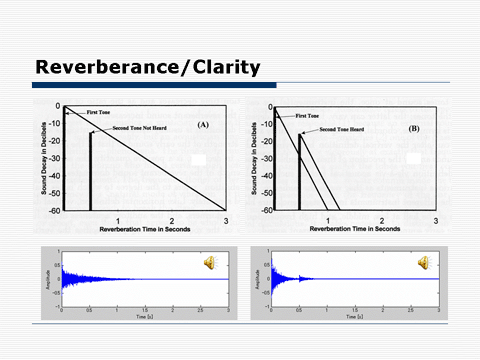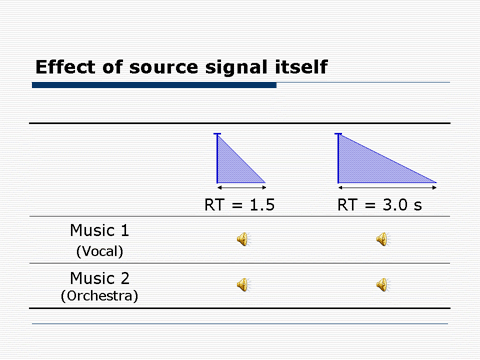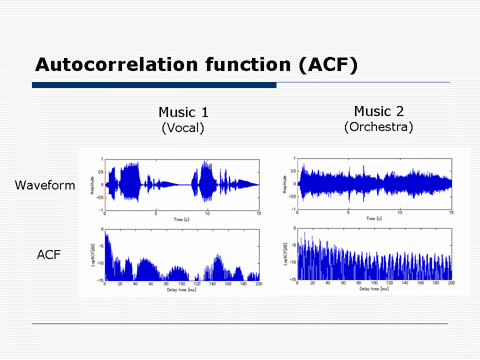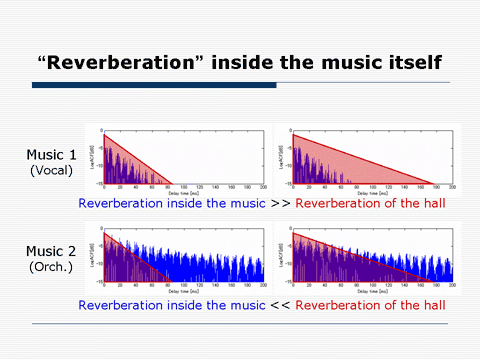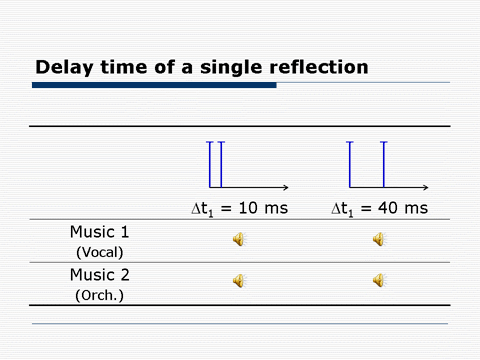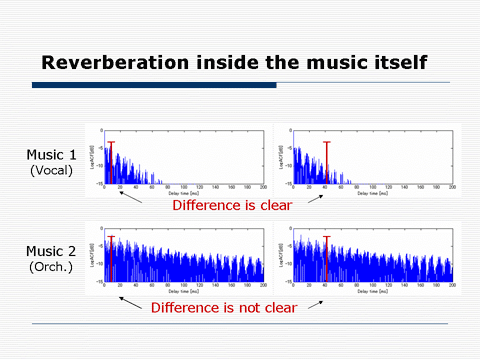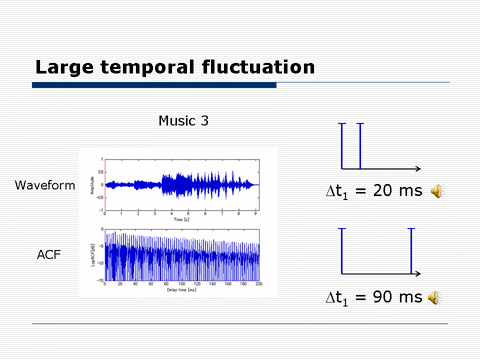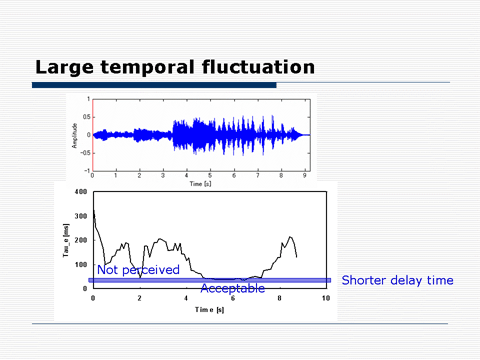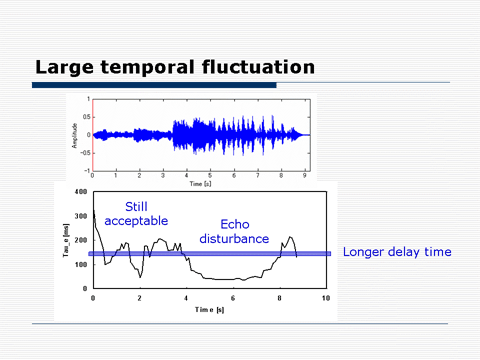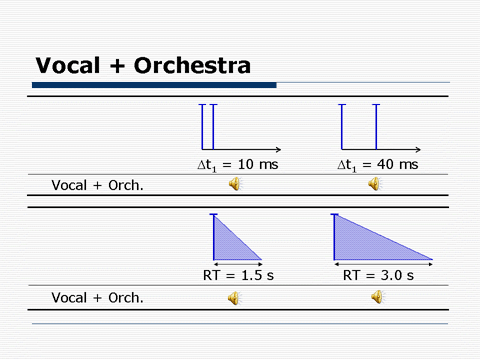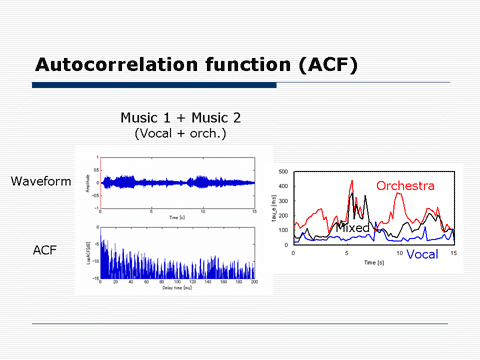Subjective prefence in terms of temporal factorsShin-ichi SATO IntroductionThere are three elements of room acoustics: sound source, sound field, and listeners. These are affected by each other. For example, we can adjust the reverberation time of a room according to the characteristics of the sound source. Speech sound is suitable for a space with short reverberation time, and the orchestra music is usually performed in a space with long reverberation. We can choose the seat of a concert hall according to our acoustical preference. The frontal seat has the sound field with clarity and of course large sound energy. The rear seat receives a lot of diffused reflections, thus, more reverberance and envelopment. In this presentation, I would like to enphasize that the listener's hearing impression of the temporal factor like the initial time delay gap sound filed is greatly affetted by the temporal characteristics of the sound source. Effect of sound filedIn auditorium like a concert hall and an opera house, sounds from the stage are reflected by boundaries like canopies, walls, ceilings and balconies. In the early part of an impulse response, each reflection is discrete. The tail part is perceived as a group of reflections, that is, reverberation. These temporal structures affact the hearing impression of the music."Clarity" and "reverberance" are important attributes in a musical performance in terms of temporal factors of a sound field.
These two examples are based on Figure 2.3 of "L. L. Beranek, Concert Hall Acoustics: Music, Acoustics, and Architecture, Springer Verlag/Acoustical Society of America, New York (1996)" and show two successive pulses with different length of reverberation. In example (A), the reverberation of the first pulse overlaps with the second pulse. Two sounds are merged together (SOUND 1). On the other hand, in example (B), the reverberation of the first pulse terminates before the second pulse (SOUND 2). Therefore, the second pulse can be heard clearly.
SOUND 1: Two pulses with 3.0s reverberation SOUND 2: Two pulses with 1.0s reverberation But actual sound source is not a pulse. The musical performance consists of various instruments and vocals. A reverberation inside a music signal itself has a large effect on the hearing impression as well as a reverberation of a hall. Reververation time and source singal
For a vocal source, there is clear difference between long (RT = 3.0 s) and short (RT = 1.5 s) reverberation of a hall (SOUND 3 and 4) On the other hand, for the orchestra source, difference between two reverberations is not so clear (SOUND 5 and 6).
SOUND 3: Soprano vocal with 1.5 s of reverberation
SOUND 4: Soprano vocal with 3.0 s of reverberation
SOUND 5: Orchestra music with 1.5 s of reverberation
SOUND 6: Orchestra music with 3.0 s of reverberation From where does these differences come? Not only the characteristics of sound field but also the characteristics of sound source itself affects the hearing impression. Autocorrelation function of source signal
Autocorrelation function of a source signal can describe the amount of the reverberation inside a music signal. MOVIES 1 and 2 show the ACF of the vocal and the orchestra sources respectively. You can see the difference of amount of "reverberation" inside music between two sounds.
MOVIE 1: Upper figure: Wavefom of vocal source (soprano); Bottom Figure: Running ACF of vocal source (soprano). Integration interval 2T is 1.0 s.
MOVIE 2: Upper figure: Wavefom of orchestra source; Bottom Figure: Running ACF of orchestra source. Integration interval 2T is 1.0 s.
These diagrams explain the relationship between the reverberation of a hall and the autocorrelation function of the music signals. When the reverberation inside music is long, it covers the reverberation of a hall and the difference of the hall reverberation can be hardly perceived. Reververation time and source singal
This ACF is also deeply related to the simplest sound field with the direct sound and a single reflection. When a single reflections with different delay time are added to the direct sound of a vocal sound, the sounds are like these (SOUND 7 and 8). When a single reflections are added to the direct sound of an orchestra sound, the sounds are like these (SOUND 9 and 10). It is easier to perceive a difference for a vocal source. SOUND 7: Vocal spurce (soprano) with a reflection of 10ms delay SOUND 8: Vocal source (soprano) with a reflection of 40ms delay SOUND 9: Orchestra source with a reflection of 10ms delay SOUND 10: Orchestra source with a reflection of 40ms delay
These diagrams explain the relationship between a single reflection and the reverberation inside a music signal itself. When the reverberation inside music is long, it covers a single reflection and the difference of the delay time is hardly perceived.
Next example is that the reverberation inside a music is fluctuating greatly (MOVIE 3). In the part marked by a circle, the reverberation inside the music is very small. First, the reflection with a short delay time is added to the vocal source (SOUND 11) Next, a long delay time reflection is added (SOUND 12). You can hear the difference in the part. MOVIE 3: ACF of music (2T = 1.0s) SOUND 11: Music with a reflection of 20 ms delay SOUND 12: Music with a reflection of 90 ms delay
This figure shows the temporal fluctuation of the reverberation inside the music. The reflection with short delay time is acceptable in this part, and in other parts, the effect of the reflection on the perception is minor.
On the other hand, the reflection with long delay time becomes a harmful echo in this part. In other parts, the reflection is still acceptable.
Next example is the combination of the music signals. The motif is the same vocal and orchestra. First, single reflections with different delay times are added (SOUND 13 and 14). Next, different length of reverberation are added (SOUND 15 and 16). The effect of the hall is clearer for the vocal source than the orchestra. SOUND 13: Vocal + Orchestra with a reflection of 10 ms delay SOUND 14: Vocal + Orchestra with a reflection of 40 ms delay SOUND 15: Vocal + Orchestra with 1.5s reverberation SOUND 16: Vocal + Orchestra with 3.0s reverberation
To describe the amount of the reverberation inside a music signal, autocorrelation analysis is also utilized. This movie shows the ACF of the mixed signal (MOVIE 1). The part indicated in blue, ACF of mixed signal is similar to that of the vocal, and the part in red, ACF is similar to that of the orchestra. ACF of mixed sound may be controlled by the balance of the levels between two signals. MOVIE 4: ACF of Vocal + Orchestra RemarksListener's hearing impression for the temporal factors of a sound filed is greatly affetted by the temporal characteristics of the sound source, which can be described by the ACF of the sound source. The suitable music for a given hall can be selected by focusing the part which have a smallest reverberation inside a music itself. |
